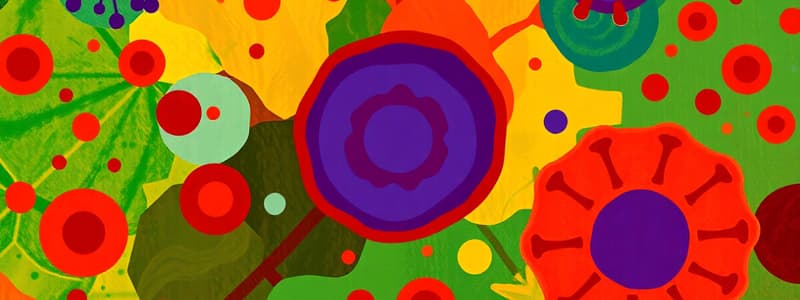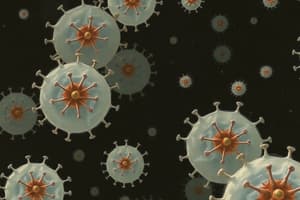Podcast
Questions and Answers
Which blood cell type is primarily responsible for attacking and killing parasites?
Which blood cell type is primarily responsible for attacking and killing parasites?
Which cell type is known for creating antibodies to defend against pathogens?
Which cell type is known for creating antibodies to defend against pathogens?
What is a primary function of neutrophils in the immune response?
What is a primary function of neutrophils in the immune response?
Which blood cell has a significant role in the detection, engulfing, and destruction of pathogens?
Which blood cell has a significant role in the detection, engulfing, and destruction of pathogens?
Signup and view all the answers
Which of the following blood cells is characterized by a large surface area for efficient diffusion?
Which of the following blood cells is characterized by a large surface area for efficient diffusion?
Signup and view all the answers
What is the primary function of erythrocytes in blood?
What is the primary function of erythrocytes in blood?
Signup and view all the answers
Which component of plasma is most responsible for maintaining osmotic pressure in the blood?
Which component of plasma is most responsible for maintaining osmotic pressure in the blood?
Signup and view all the answers
Which of the following ions is NOT typically found in blood plasma?
Which of the following ions is NOT typically found in blood plasma?
Signup and view all the answers
What is the primary role of leukocytes in blood?
What is the primary role of leukocytes in blood?
Signup and view all the answers
Which component makes up the majority of blood volume?
Which component makes up the majority of blood volume?
Signup and view all the answers
What distinguishes arterioles from arteries?
What distinguishes arterioles from arteries?
Signup and view all the answers
Which of the following characteristics is true for veins?
Which of the following characteristics is true for veins?
Signup and view all the answers
What is the primary function of capillaries in the circulatory system?
What is the primary function of capillaries in the circulatory system?
Signup and view all the answers
Which statement is correct regarding the blood characteristics in arteries and veins?
Which statement is correct regarding the blood characteristics in arteries and veins?
Signup and view all the answers
What is the primary role of arterioles in the circulatory system?
What is the primary role of arterioles in the circulatory system?
Signup and view all the answers
What is the primary function of the tendinous cords in the heart?
What is the primary function of the tendinous cords in the heart?
Signup and view all the answers
Which of the following statements accurately describes the aorta?
Which of the following statements accurately describes the aorta?
Signup and view all the answers
Identify the correct pairing of heart chambers and their blood flow direction.
Identify the correct pairing of heart chambers and their blood flow direction.
Signup and view all the answers
What distinguishes the function of the superior and inferior vena cavas?
What distinguishes the function of the superior and inferior vena cavas?
Signup and view all the answers
Which heart feature is primarily responsible for the initial intake of blood returning from the body?
Which heart feature is primarily responsible for the initial intake of blood returning from the body?
Signup and view all the answers
What is the role of the pulmonary artery in the circulatory system?
What is the role of the pulmonary artery in the circulatory system?
Signup and view all the answers
Which of the following statements about veins and arteries is correct?
Which of the following statements about veins and arteries is correct?
Signup and view all the answers
Which substances are absorbed into the blood as it passes through the small intestine?
Which substances are absorbed into the blood as it passes through the small intestine?
Signup and view all the answers
What type of blood returns to the heart via the vena cava?
What type of blood returns to the heart via the vena cava?
Signup and view all the answers
Which structure is responsible for carrying blood from the heart to the kidneys?
Which structure is responsible for carrying blood from the heart to the kidneys?
Signup and view all the answers
During which phase of the cardiac cycle does the left AV valve close?
During which phase of the cardiac cycle does the left AV valve close?
Signup and view all the answers
What physiological change occurs during isovolumetric contraction?
What physiological change occurs during isovolumetric contraction?
Signup and view all the answers
Which heart sound corresponds with the closure of the aortic valve?
Which heart sound corresponds with the closure of the aortic valve?
Signup and view all the answers
What is the heart rate when one complete cardiac cycle lasts 0.6 seconds?
What is the heart rate when one complete cardiac cycle lasts 0.6 seconds?
Signup and view all the answers
What delivery capacity change occurs between the left and right ventricles?
What delivery capacity change occurs between the left and right ventricles?
Signup and view all the answers
At which time does the AV valve close in relation to the left atrium pressure?
At which time does the AV valve close in relation to the left atrium pressure?
Signup and view all the answers
Which event occurs at 0.5 seconds in the cardiac cycle?
Which event occurs at 0.5 seconds in the cardiac cycle?
Signup and view all the answers
What condition must be met for the semilunar valve to remain closed?
What condition must be met for the semilunar valve to remain closed?
Signup and view all the answers
During which time does the pressure in the left ventricle exceed the pressure in the aorta first during the cycle?
During which time does the pressure in the left ventricle exceed the pressure in the aorta first during the cycle?
Signup and view all the answers
What happens to the pressure in the left ventricle at 0.6 seconds?
What happens to the pressure in the left ventricle at 0.6 seconds?
Signup and view all the answers
During which phase of the cardiac cycle are the AV valves closed?
During which phase of the cardiac cycle are the AV valves closed?
Signup and view all the answers
What happens to the semi-lunar valves during Diastole?
What happens to the semi-lunar valves during Diastole?
Signup and view all the answers
Which sequence correctly describes blood flow during Atrial Systole?
Which sequence correctly describes blood flow during Atrial Systole?
Signup and view all the answers
How long does one complete cardiac cycle take?
How long does one complete cardiac cycle take?
Signup and view all the answers
What is the state of the heart during Ventricular Systole?
What is the state of the heart during Ventricular Systole?
Signup and view all the answers
What initiates the electrical activity in the heart that causes its contraction?
What initiates the electrical activity in the heart that causes its contraction?
Signup and view all the answers
What is the role of Purkinje fibres in the cardiac conduction system?
What is the role of Purkinje fibres in the cardiac conduction system?
Signup and view all the answers
Why is the heart muscle described as myogenic?
Why is the heart muscle described as myogenic?
Signup and view all the answers
What is the consequence of the time delay at the AVN?
What is the consequence of the time delay at the AVN?
Signup and view all the answers
Which path does the electrical impulse follow after leaving the AVN?
Which path does the electrical impulse follow after leaving the AVN?
Signup and view all the answers
What does the P wave in an ECG represent?
What does the P wave in an ECG represent?
Signup and view all the answers
What is the significance of the delay between the P wave and the QRS wave?
What is the significance of the delay between the P wave and the QRS wave?
Signup and view all the answers
Which wave in the ECG indicates the recovery phase of the ventricles?
Which wave in the ECG indicates the recovery phase of the ventricles?
Signup and view all the answers
How is the heart rate calculated from an ECG trace?
How is the heart rate calculated from an ECG trace?
Signup and view all the answers
In an ECG, what does the QRS wave indicate?
In an ECG, what does the QRS wave indicate?
Signup and view all the answers
Flashcards
What is blood?
What is blood?
A specialized tissue that carries oxygen, nutrients, and waste products around the body, fights infections, helps regulate temperature, and maintains pH balance.
What is plasma?
What is plasma?
The liquid component of blood that contains water, proteins, ions, nutrients, waste products, and gases.
What are platelets?
What are platelets?
Tiny cells responsible for blood clotting, preventing excessive bleeding.
What do red blood cells do?
What do red blood cells do?
Signup and view all the flashcards
What do white blood cells do?
What do white blood cells do?
Signup and view all the flashcards
Phagocyte
Phagocyte
Signup and view all the flashcards
Monocyte
Monocyte
Signup and view all the flashcards
Lymphocyte
Lymphocyte
Signup and view all the flashcards
Neutrophil
Neutrophil
Signup and view all the flashcards
Erythrocyte
Erythrocyte
Signup and view all the flashcards
Aorta
Aorta
Signup and view all the flashcards
Vena Cava
Vena Cava
Signup and view all the flashcards
Arteries
Arteries
Signup and view all the flashcards
Veins
Veins
Signup and view all the flashcards
Oxygenation
Oxygenation
Signup and view all the flashcards
Capillaries
Capillaries
Signup and view all the flashcards
Venules
Venules
Signup and view all the flashcards
Superior and Inferior Vena Cava
Superior and Inferior Vena Cava
Signup and view all the flashcards
Atria (Right and Left)
Atria (Right and Left)
Signup and view all the flashcards
Ventricles (Right and Left)
Ventricles (Right and Left)
Signup and view all the flashcards
Atrioventricular (AV) Valves
Atrioventricular (AV) Valves
Signup and view all the flashcards
Diastole
Diastole
Signup and view all the flashcards
Atrial Systole
Atrial Systole
Signup and view all the flashcards
Ventricular Systole
Ventricular Systole
Signup and view all the flashcards
Cardiac Cycle
Cardiac Cycle
Signup and view all the flashcards
Myogenic Heart
Myogenic Heart
Signup and view all the flashcards
Depolarization
Depolarization
Signup and view all the flashcards
Sino-atrial node (SAN)
Sino-atrial node (SAN)
Signup and view all the flashcards
Atrio-ventricular node (AVN)
Atrio-ventricular node (AVN)
Signup and view all the flashcards
Bundle of His
Bundle of His
Signup and view all the flashcards
Valve opening
Valve opening
Signup and view all the flashcards
Valve closing
Valve closing
Signup and view all the flashcards
Aortic valve opening
Aortic valve opening
Signup and view all the flashcards
Aortic valve closing
Aortic valve closing
Signup and view all the flashcards
Pressure changes during the cardiac cycle
Pressure changes during the cardiac cycle
Signup and view all the flashcards
ECG (Electrocardiogram)
ECG (Electrocardiogram)
Signup and view all the flashcards
P wave
P wave
Signup and view all the flashcards
QRS complex
QRS complex
Signup and view all the flashcards
T wave
T wave
Signup and view all the flashcards
Why is there a delay between the P and the QRS wave?
Why is there a delay between the P and the QRS wave?
Signup and view all the flashcards
Ventricular Pressure
Ventricular Pressure
Signup and view all the flashcards
Aortic Valve Function
Aortic Valve Function
Signup and view all the flashcards
Heart Sounds: Lubb & Dupp
Heart Sounds: Lubb & Dupp
Signup and view all the flashcards
Cardiac Cycle Graph
Cardiac Cycle Graph
Signup and view all the flashcards
Heart Rate Calculation
Heart Rate Calculation
Signup and view all the flashcards




